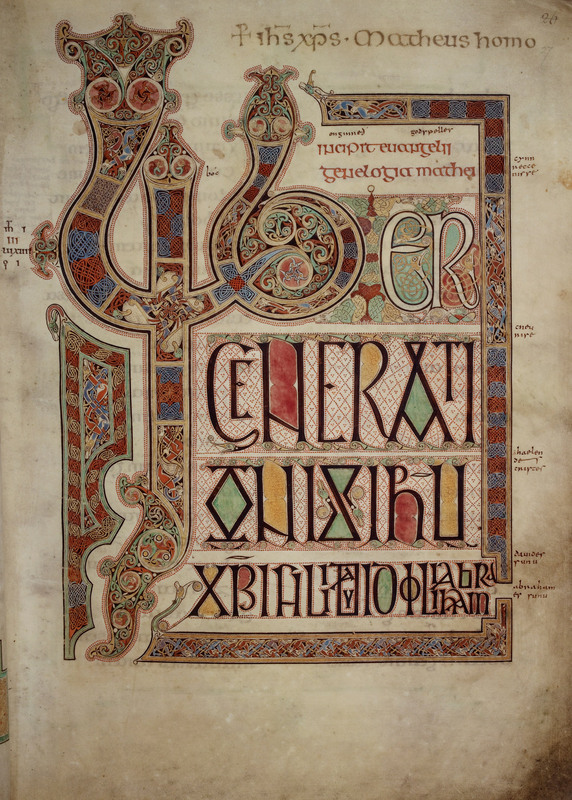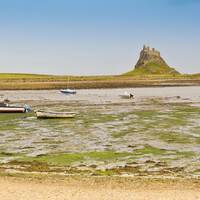Lindisfarne Gospels
Date:
ca. 720
Location or Findspot (Modern-Day Country):
United Kingdom
Medium:
Parchment
Dimensions:
36.5 × 27.5 cm
Description:
This manuscript includes the Latin text of the Gospels as well as an Old English interlinear gloss (added in the mid-tenth century). The colophon says that the book was written "for God and for St. Cuthbert and for all the saints whose remains are on the island" by the scribe Eadfrith, "bishop of the Lindisfarne church," and was bound by Aethelwald (later a bishop) and encased in metal and jewels by Billfrith the anchorite (hermit).
Eadfrith created an impressive range of colors using only a few pigments, all derived from animal, vegetable, or mineral sources and bound together with egg whites and vinegar (glair). Blue, crimson, and purple come from such plants as woad and lichen, while different shades of green were produced by mixing blue and yellow or by suspending copper over vinegar (verdigris). Yellow was made from orpiment, an arsenic-sulfide mineral, and red and orange from toasted lead. White was obtained from chalk, seashells, or eggshells. The black pigment in the illuminations is carbon-based lampblack, made from soot, whereas the black ink used for the script is made of oak galls (the apple-shaped hollows formed by wasps laying eggs on an oak tree) and iron salts.
The only use of gold is for the evangelists' names, which thereby reflect the light of Christ transmitted by the Gospels. On the whole, Eadfrith used color more naturalistically than his contemporaries, who favored greater abstraction: Matthew's hair is salt-and-pepper gray, Mark's lion symbol is dun-colored rather than yellow. The colors used for the evangelists' garments are probably symbolic. While each has his own primary hue, color correspondences with the book's other evangelist images underscore the harmony of the Gospels. Striations suggest heavenly light as well as modeling through abstract, stylized patterns. Sourcing organic substances like those used in the Lindisfarne Gospels and processing them for use in art involved time, trade, and many forms of specialized knowledge. That said, medieval artists were not aware that many of the raw and manufactured materials they were using are highly toxic.
Relevant Primary Sources
Eadfrith created an impressive range of colors using only a few pigments, all derived from animal, vegetable, or mineral sources and bound together with egg whites and vinegar (glair). Blue, crimson, and purple come from such plants as woad and lichen, while different shades of green were produced by mixing blue and yellow or by suspending copper over vinegar (verdigris). Yellow was made from orpiment, an arsenic-sulfide mineral, and red and orange from toasted lead. White was obtained from chalk, seashells, or eggshells. The black pigment in the illuminations is carbon-based lampblack, made from soot, whereas the black ink used for the script is made of oak galls (the apple-shaped hollows formed by wasps laying eggs on an oak tree) and iron salts.
The only use of gold is for the evangelists' names, which thereby reflect the light of Christ transmitted by the Gospels. On the whole, Eadfrith used color more naturalistically than his contemporaries, who favored greater abstraction: Matthew's hair is salt-and-pepper gray, Mark's lion symbol is dun-colored rather than yellow. The colors used for the evangelists' garments are probably symbolic. While each has his own primary hue, color correspondences with the book's other evangelist images underscore the harmony of the Gospels. Striations suggest heavenly light as well as modeling through abstract, stylized patterns. Sourcing organic substances like those used in the Lindisfarne Gospels and processing them for use in art involved time, trade, and many forms of specialized knowledge. That said, medieval artists were not aware that many of the raw and manufactured materials they were using are highly toxic.
Relevant Primary Sources
Relevant Textbook Chapter(s):
4
Repository and Online Resources:
• See the digitized Lindisfarne Gospels (Cotton MS Nero D IV) on the website of the British Library.
Image Credits:
British Library (MS Viewer online)







